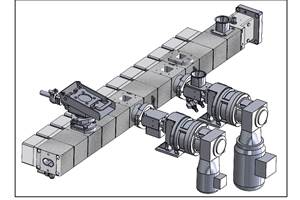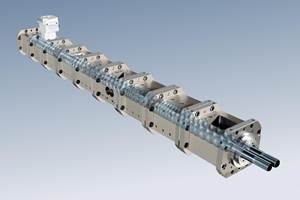New Customizable Additives for Polyolefins and PVC
Developing a wide range of customizable additives to meet specific needs in polyolefins and PVC is a major thrust at Chemtura Corp., Middlebury, Conn.
Developing a wide range of customizable additives to meet specific needs in polyolefins and PVC is a major thrust at Chemtura Corp., Middlebury, Conn. With a “greener is better” approach, the world’s largest plastics additives producer aims to develop additives that are more environmentally friendly than those they replace while also providing improvements in cost and performance. Marcus Meadowsmith, Chemtura’s new executive v.p., and Dr. Michael J. Goode, v.p. of technology for plastics additives, recently discussed examples of this initiative with Plastics Technology editors.
They also emphasized that 2006 was a busy year for Chemtura. In that time the firm accomplished the organizational task of integrating Great Lakes Chemical and Crompton Corp., which merged to form Chemtura Corp. on July 1, 2005. In addition, Chemtura fully restored and upgraded its customer care center in Taft, La., that was knocked out of commission by Hurricane Katrina.
Targeted for polyolefins
Among the most recent developments in additives for polyolefins are specialty grades that expand the Polybond line of polymer modifiers. One is Polybond 1103, a high-flow adhesion promoter. This acrylic-acid-grafted PP homopolymer was designed to promote adhesion of soft TPOs and TPVs to metals, glass, and engineering resins like nylon. In recent trials with an 87 Shore A TPV, Polybond 1103 reportedly showed better adhesion to both aluminum and stainless steel than Polybond 1001, a general-purpose AA-grafted PP. Available in pellet form, it contains 6% acrylic acid, similar to Polybond 1001.
Another Polybond specialty grade, initially customized for one user, is expected to become commercially available this year. A maleic-anhydride-grafted PE-based modifier, this one is designed to function as a coupling agent in wood- and other natural-fiber composites. Said Goode, “The product has a higher maleic anhydride content than other Polybond modifiers and has 20% higher efficiency, allowing 20% lower use levels.” Polybond coupling agents also show potential for use in nanocomposites, according to Goode.
Also in development are new “non-interfering” lubricants optimized specifically for use with coupling agents in wood-plastic composites. Said Goode, “We are aiming to address the need for lubricants that work well with a coupling agent and also eliminate interference with iron oxide pigments, particularly in high-wood-content composites.”
Meanwhile, Process Plus is a further expansion of Chemtura’s Anox line of proprietary antioxidant blends. Process Plus blends are made from different building blocks, which may include hindered phenolic and non-phenolic antioxidants in combination with other processing stabilizers. They are targeted for polyolefin applications requiring extra stabilization, such as microwaveable and medical packaging. These low-color additive blends are non-lactone replacements for Irganox XP blends of phenolic and lactone stabilizers, which Ciba Specialty Chemicals will phase out of production this year.
Also newly commercial is Genox EP, a non-phenolic, high-performance antioxidant, a result of Chemtura’s 2003 acquisition of GE Specialty Chemicals. Although slightly higher in price than typical phenolic antioxidants, this nitrogen oxide derivative has very low color, making it better for color-sensitive polyolefin applications, according to Goode.
In uv stabilizers, Chemtura has development efforts under way toward improving cost-effectiveness of high-performance HALS, noted Meadow-Smith.
New developments for PVC
As previously reported, Chemtura’s metal-free Mark OBS (Organic Based Stabilizer) additives were originally developed for rigid PVC but have also proven their mettle in flexible applications (see “Learn More” box above). These “green” alternatives to heavy-metal stabilizers have been used primarily in South America and Europe, but Goode and Meadow-Smith said interest has emerged in North America for niche applications such as flooring. In Europe, makers of safety flooring have found that Mark OBS cuts costs by reducing the need for antistatic additives.
Interest in Mark OBS has been stimulated especially by recent improvements that make it even more attractive. “The breakthrough is in both cost efficiency and an increased processing window,” said Goode. Recent trials demonstrate the broader processing window of the new-generation OBS versus calcium-zinc, lead, and first-generation OBS (see graph). Applications targeted include vinyl edging profiles for furniture and automotive applications.
Related Content
Understanding 'Boundary Conditions' in Twin-Screw Compounding
In twin-screw compounding, the objective is generally to produce the highest quality product at the maximum strand. But sometimes there are operating parameters that prevent this objective from being realized.
Read MoreStrategically Manage Pressure to Help Ensure Quality in Co-Rotating Twin-Screw Extrusion
Pressure measurement provides an invaluable window into any extrusion process, but it must also be strategically managed at every stage of the process to ensure a quality part is being extruded.
Read MoreHow to Configure Your Twin-Screw Barrel Layout
In twin-screw compounding, most engineers recognize the benefits of being able to configure screw elements. Here’s what you need to know about sequencing barrel sections.
Read MoreStandardized Extruder Can Be Used Anywhere
Machine can be manufactured anywhere the customer is with the same specifications, design, support and goal to advance their materials.
Read MoreRead Next
Organic PVC Stabilizers Move from Europe to U.S.
A line of organic PVC heat stabilizers designed to replace heavy-metal stabilizers in environmentally sensitive European markets is now gaining a foothold in North America.
Read MoreFor PLASTICS' CEO Seaholm, NPE to Shine Light on Sustainability Successes
With advocacy, communication and sustainability as three main pillars, Seaholm leads a trade association to NPE that ‘is more active today than we have ever been.’
Read MoreLead the Conversation, Change the Conversation
Coverage of single-use plastics can be both misleading and demoralizing. Here are 10 tips for changing the perception of the plastics industry at your company and in your community.
Read More












